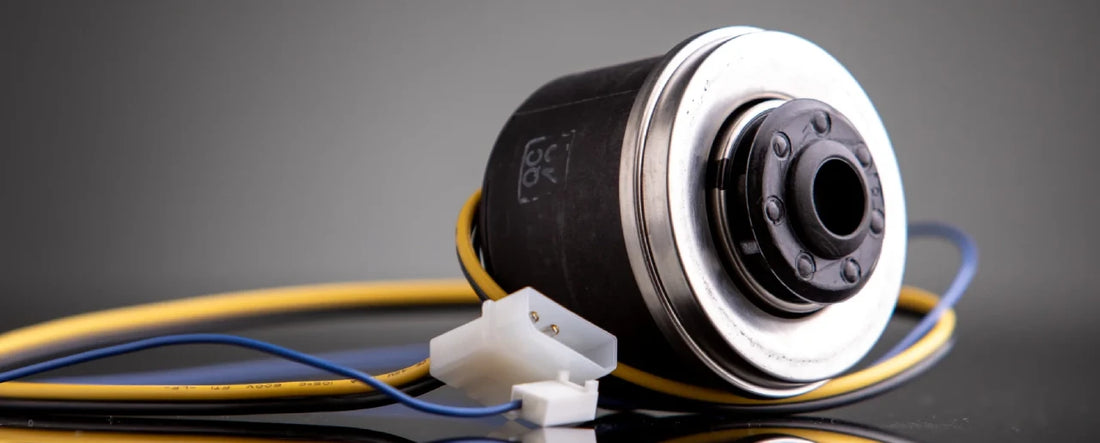
D5 Pumps: Vario or PWM?
Share
The world of watercooling is full of strange and confusing parts. On the journey to custom watercooling, it's a bit intimidating to be able to find the right parts, easily putting any off to stick with an AIO or an air cooler.
Today, we'll be looking at a subtle difference amongst D5 pumps; Vario and PWM controls.
D5 Pumps
First, let's go into some details about the pump. The D5 pump is a patented design by Xylem, who also own Laing and Lowara, and utilises a magnetic motor to drive a spherical magnetically levitated motor. The centrifugal forces from this motor draws water in and 'spins it out' at high speed to thus pump water through any opening, usually up to around 4800 rpm. It's a design that's been tried and tested over decades and is famed for their reliability and performance.
Xylem also makes these pumps as OEM parts for many of the major brands; Aquacomputer, Alphacool, Bitspower, Corsair, EKWB, Thermaltake, Watercool, XSPC and more. As it's a standard design, these pumps will fit into any D5 specced reservoir.
With that said, all D5 pumps are equal... but some are more equal.
Vario Pumps

When it comes to Vario pumps, these utilise a simple adjustable switch to control their speed. On the backplate, there are usually 5 different settings. Starting off at about 37.5% pump speed and increasing in steps of about 15.625%. A 3 pin tachometer cable usually accompanies these pumps for speed monitoring into a motherboard header. These pumps are also powered by a 4 pin molex connector, though some can come in SATA varieties
PWM Pumps

PWM pumps do away with the manual switch and 3 pin tachometer cable in favour of a 4 pin PWM one. When connected to a motherboard or control hub connector, this allows for much finer control via software to control the speed of the pump. Just like the vario version, these pumps are controlled by either 4 pin molex or sata power connections.

So is PWM better for me?
Yes and no. Whilst finer control of the pump is nice to have, in certain situations a fixed speed might be all you need in your loop. Increasing the flow rate of your loop has diminishing returns past a certain point; when you coolant is moving fast enough, there is very little difference in coolant temperate at a hotspot such as the GPU compared to a point at the radiator. This is because the coolant will absorb or lose less heat since it's not staying in one point, compared to a slow rate.
In a loop with lower restrictions, running the pump at about one of the lower settings on the vario may be sufficient, with the added benefit of a lower noise output and slightly lower power consumption. For those with external radiators, a fixed setting will work well and saves the need for running additional cables back to the main rig for control.
Compared to the PWM, the finer control makes it ideal for those that operate in a more variable environment. Take for example, when you're casually streaming videos or browsing emails, you can adjust your PWM signals to reduce pump speeds and noise. When you put on your favourite headphones and start doing some heavier gaming or rendering, your presets can then ramp up the pump speeds when a louder rig isn't of concern.
Is there a pump that's even more equal?...
Yep. The Aquacomputer D5 NEXT. This is the bee's knees of D5 pumps. Whilst it utilises the same motor, the additional controller adds a huge amount of functionality to the motor.

The pump unit connects internally into one of your motherboards USB headers and provides information such as pump speeds, coolant temperature, and an acoustic alarm which can be configured for anything such as dropped pumps speeds or overheating coolant. The flow meter on the unit is based on a digital calculated rate which has been calibrated for use with Aquacomputer's Double Protect Ultra.
If used on an external rad, the pump itself can be configured as a standalone unit, with it's OLED readout display, the pump and fan speeds can also be controlled, providing up to 25 watts of power via the integrated fan controller which also has speed monitoring.
Oh and it has integrated RGBs. That should give an extra 5 fps boost.
In closing, you can't go wrong with either vario or PWM D5 pumps, each provides the same performance with it all coming down to the amount of control you need. And for those that want a bit more functionality in their pump, the D5 NEXT has you covered.
